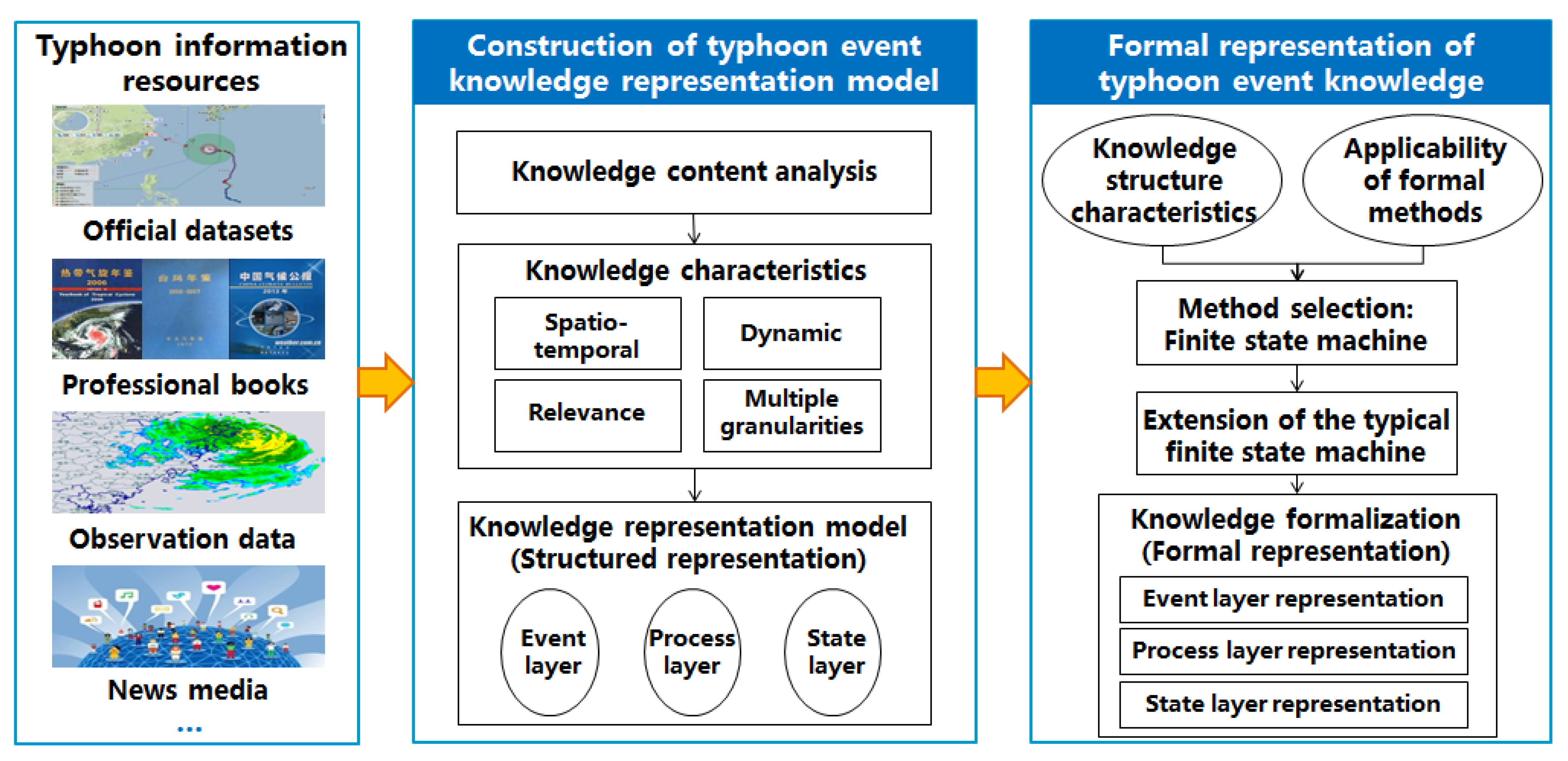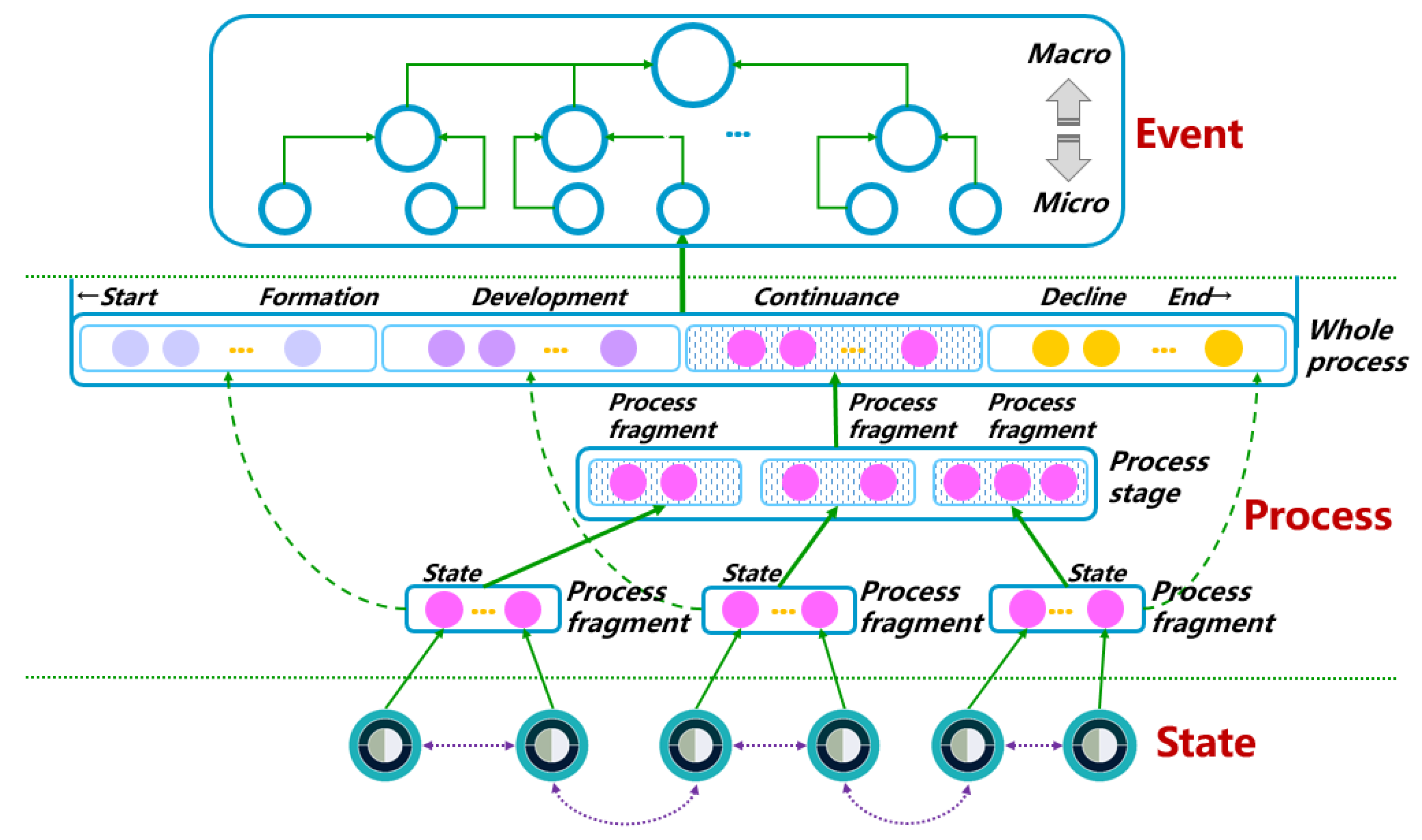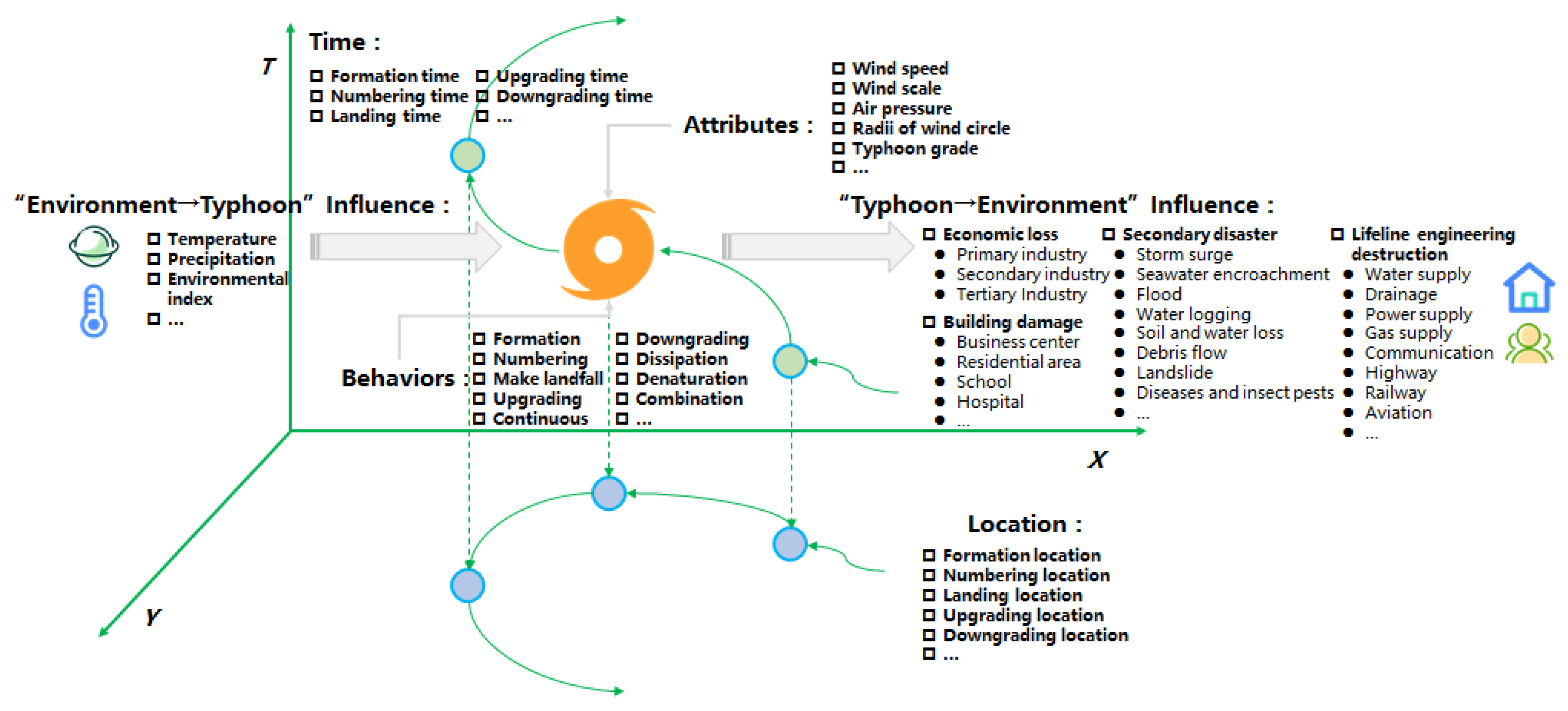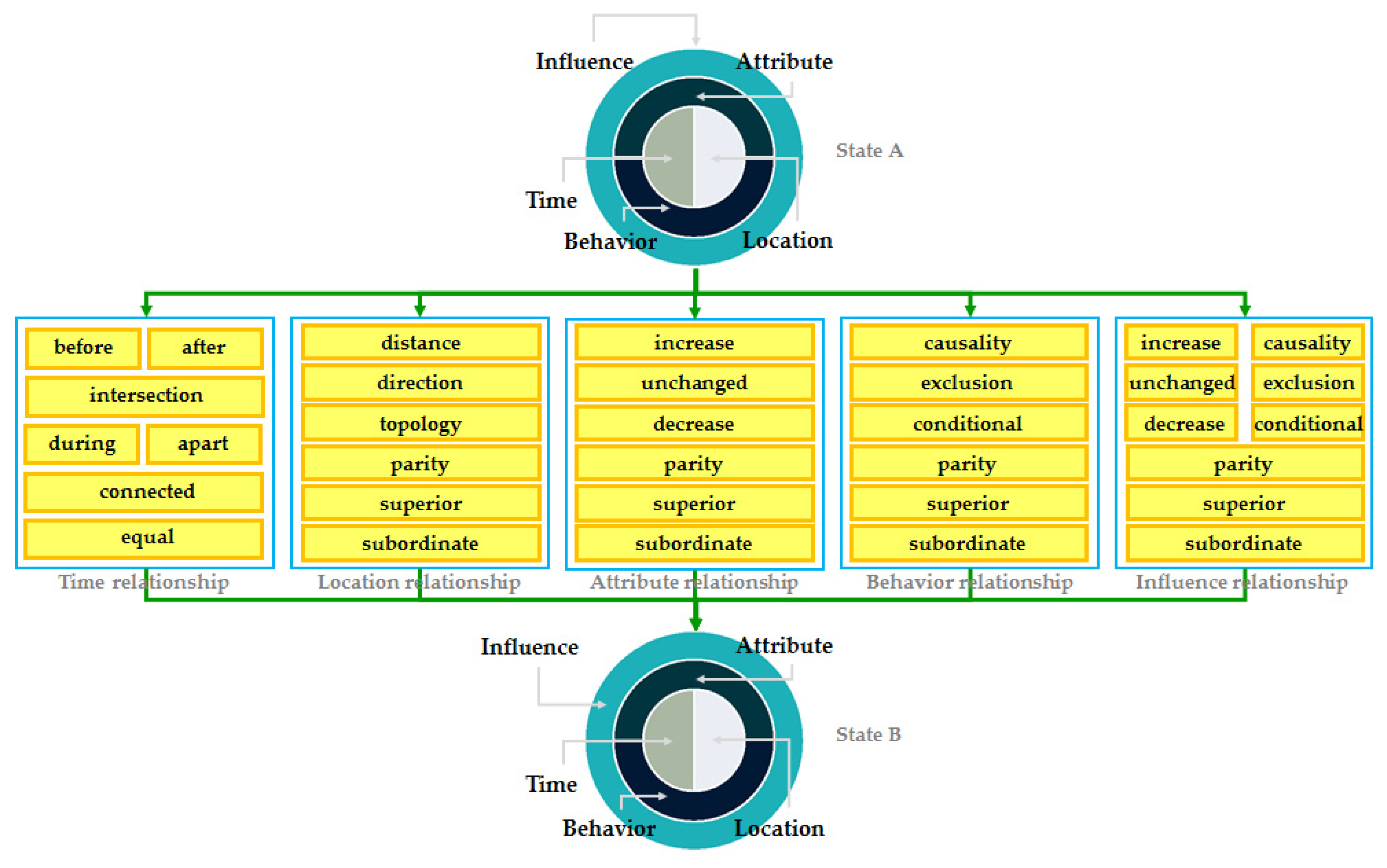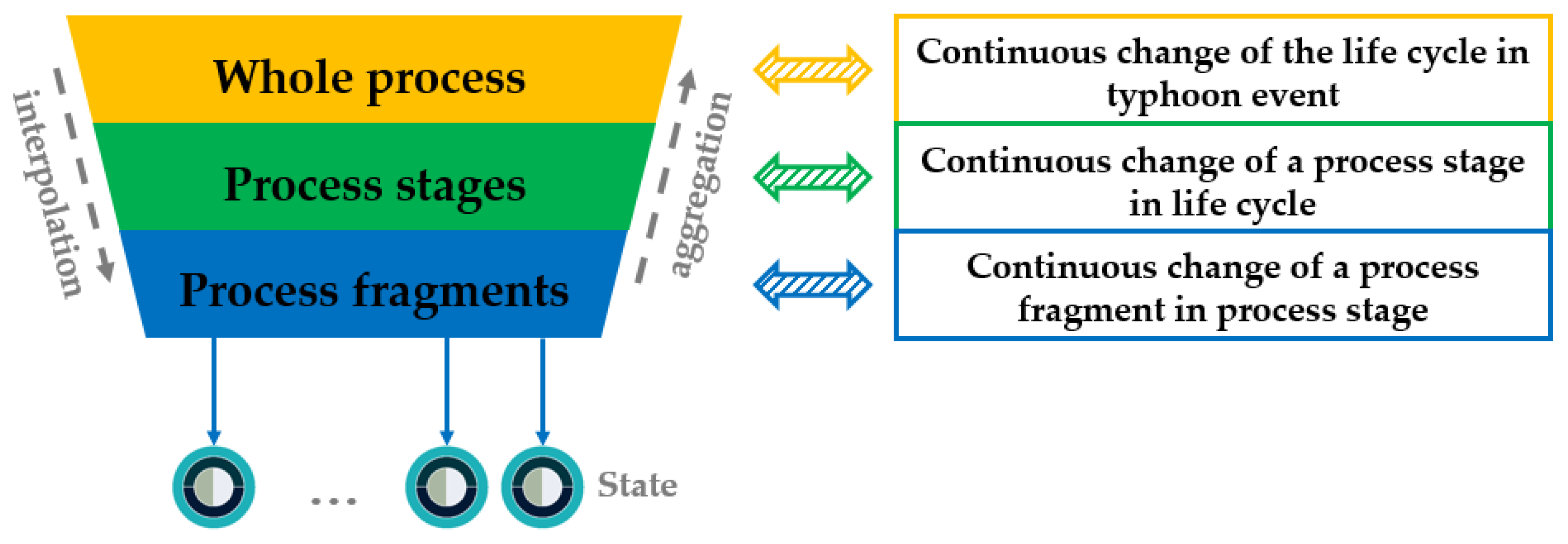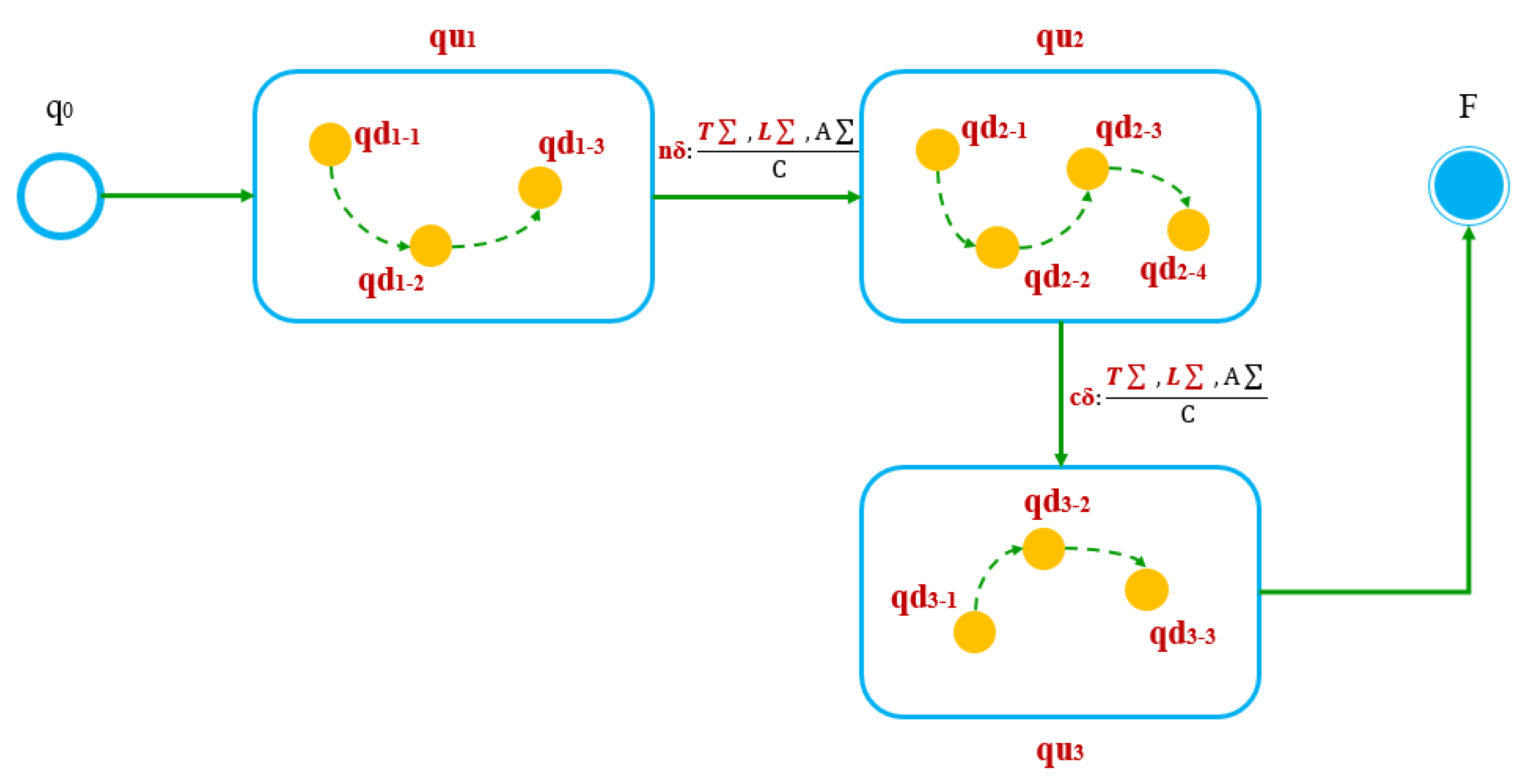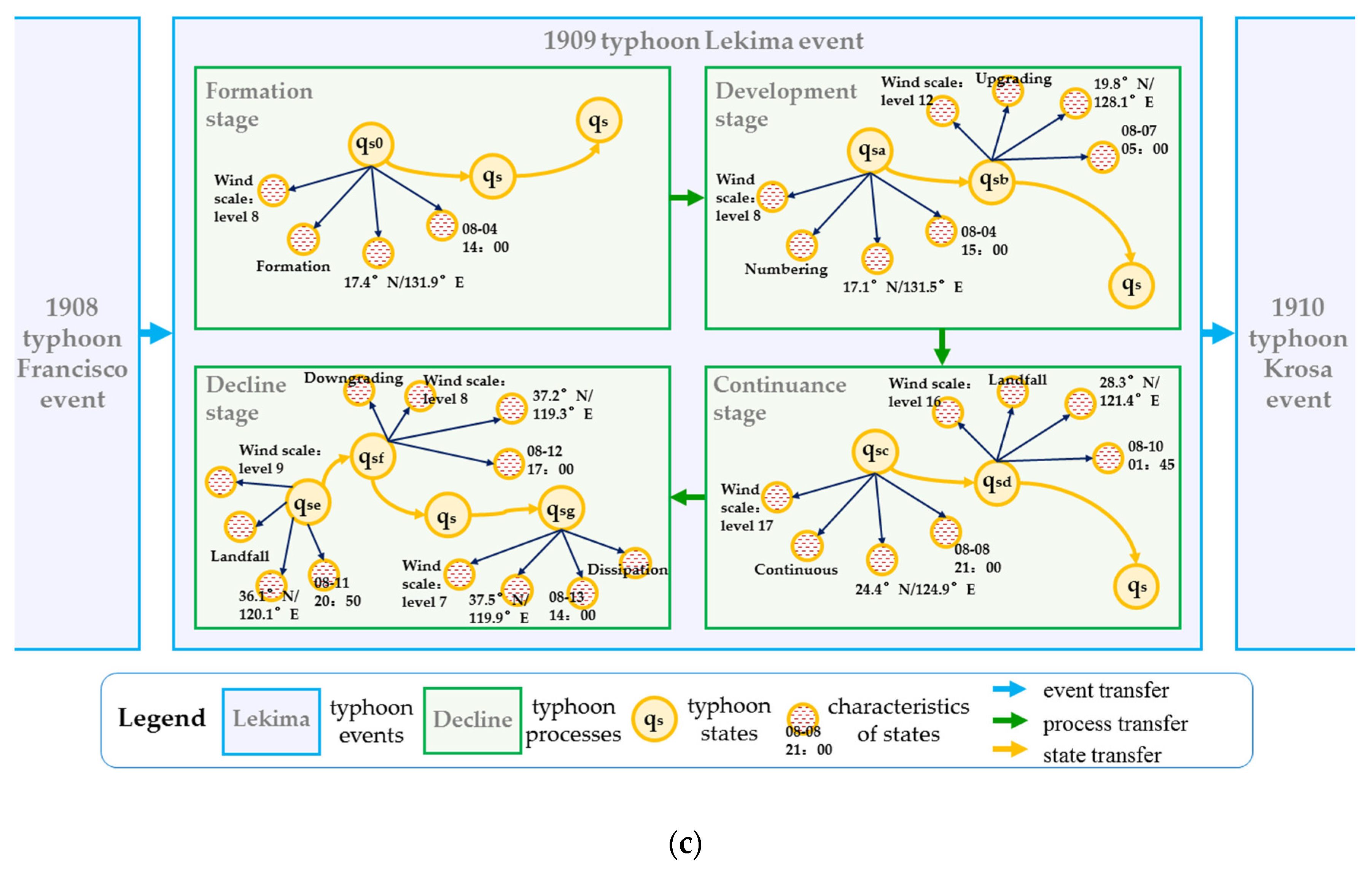1. Introduction
Typhoons are natural hazards occurring in the northwest Pacific and South China Sea, which are accompanied by intense releases of enormous amounts of energy [
1,
2]. When a typhoon passes through an area, it will not only cause strong winds, rainstorms, and huge waves, but also easily lead to flooding, debris flow, landslides, and other secondary disasters [
3]. Every year, typhoon events cause direct economic losses amounting to over
$100 billion to over 10 million people, making it one of the most destructive hazards in the world [
4].
The reason why a typhoon is so destructive is not only the bad weather, but also the complex and changeable evolution process that brings great uncertainty to hazard management. For a long time, people have accumulated a lot of information about typhoons, such as historical information and real-time observation information. Due to the lack of effective information mining and sorting, it is difficult to generate typhoon knowledge using only information technology. Knowledge is the understanding of the links between repeatable information that is formed through the processing, interpretation, selection, and transformation of information [
5]. The generation of a typhoon hazard is often driven by the evolution of the typhoon such that the evolution law and pattern of a typhoon for a given time and location is a kind of valuable knowledge. There is an urgent requirement for an objective description of the evolution process, the key nodes and impacts of a typhoon, and condensing the related concepts and concept relations of typhoon hazards to provide knowledge support for hazard prevention and reduction in terms of a strong scope, sufficient demonstration, and strict logic.
Knowledge representation is the basis and premise of knowledge application. On the one hand, knowledge needs to be represented before it can be organized and stored. On the other hand, knowledge representation determines the subsequent processing efficiency and application scope. Knowledge representation is a description or a group of conventions of knowledge, which is the modeling, symbolization, and formalization of knowledge. In the age of big data, knowledge representation is closely related to the strategy of transforming human knowledge into a system control structure that can be processed by computers [
6]. Knowledge representation requires not only the encoding of knowledge in the form of language, mathematics, or formal logic [
7,
8], but more importantly, the construction of a cognitive representation model [
9]. At present, the modeling of typhoon events can be divided into two types: the static conceptual model and the timeslice snapshot model. For the static conceptual model, it is usually based on an analysis of related basic concepts in the field of the typhoon, deriving the hierarchical relationship using the semantic classification of the concepts, and forming a tree structure [
10,
11,
12]. This kind of model can clearly show the different characteristics of the typhoon, but it also ignores the dynamic characteristics of the typhoon. As for the timeslice snapshot model, the contents of different indicators describing typhoons are formed into a time series according to the sequence of their generation time [
13,
14]. Although this expression reflects the dynamic changes of the typhoon to some extent, it usually only describes part of the characteristics of the typhoon (such as typhoon intensity, typhoon track, etc.), and cannot express the characteristics of the typhoon in different locations at the same time.
The essence of typhoon hazard management is managing the changing situation of a typhoon in time and determining the status and evolution trend of a typhoon hazard. However, both the static conceptual model and the timeslice snapshot model lack a description of the typhoon state or typhoon process, and do not fully express all kinds of knowledge needed for hazard management. It is noteworthy that through the study of cognitive science, linguistics, computer informatics, and other disciplines, human beings memorize and understand the real-world primarily in terms of “events,” which are important components of knowledge [
15,
16]. Thus, the event-centered knowledge representation model emerged [
17,
18,
19]. Since an event involves many kinds of entities, it is a knowledge unit with larger granularity than an entity. It can express more advanced and complicated semantic information. The use of an event as the core of knowledge modeling better reflects the characteristics of the objective world and emphasizes the dynamics of the event itself [
20,
21,
22,
23]. Models of event ontologies, event Petri networks, event frameworks, etc. have been generated [
24,
25,
26] and are being applied in the areas of emergencies, public opinion events, social security events, and so on [
27,
28,
29].
Compared with a generalized event representation, there are several factors that require more consideration in a typhoon event: (1) A typhoon is a geographical phenomenon, therefore time and location are the basic conditions for its existence. In the existing event models, time, location, and other attributes are juxtaposed, which do not reflect the characteristics of time and location as the basic framework [
30,
31]. (2) Describing the dynamics of events by depicting changes in states or intervals is still equivalent to recording a snapshot of an event at different time segments. Due to the lack of a mechanism for continuous gradual expression in the model, the continuous evolution of typhoon events cannot be effectively expressed and organized. (3) People’s cognition of events varies according to their needs and purposes. Therefore, it is necessary to abstract typhoon events and describe them using different granularities to fully understand the external causes and internal connections.
To construct the knowledge hierarchy of typhoon evolution, this study proposed a formal knowledge representation method for typhoon events (TKRM). Based on the analysis of the content characteristics of typhoon events, a knowledge representation model was constructed to describe the basic components and their relationships of knowledge and form structured knowledge of typhoon events. Furthermore, a formal method for typhoon event knowledge was established to realize the formalization of typhoon event knowledge. The main innovation of this study is reflected in the following two aspects:
- (1)
Combined with the evolution law of typhoon events and human cognitive habits, this study summarized and abstracted the content and characteristics of typhoon events, constructed the framework of the TKRM, and unified the basic components of knowledge of typhoon events and their relationships.
- (2)
Based on the structural characteristics of typhoon event knowledge, the typical finite state machine method was extended to implement the formal representation of typhoon event knowledge.
The arrangement of the main sections of this paper is as follows:
Section 2 presents the methodology for the TKRM,
Section 3 provides the experiment and evaluation of the TKRM,
Section 4 discusses the reasonableness and application value of the TKRM, and
Section 5 provides conclusions and prospective future work.
3. Experiment and Results
Super Typhoon Lekima (International Code: 1909) is the ninth named tropical storm of the 2019 Pacific typhoon season. “Lekima” was named by the Japan Meteorological Agency at 15:00 on 4 August 2019, and was upgraded to a typhoon by the China Central Meteorological Station at 5:00 on 7 August. It made landfall on the coast of Chengnan Town, Wenling City, Zhejiang Province, at 01:45 on 10 August. Then, the typhoon crossed Zhejiang and Jiangsu provinces and moved into the Yellow Sea. At 20:50 on 11 August, it made landfall again on the coast of Huangdao District, Qingdao City, Shandong Province. Since then, the typhoon moved into the Bohai Sea and continued to weaken. Eventually, the typhoon stopped numbering at 14:00 on 13 August [
48]. Based on the TKRM, the knowledge of the typhoon Lekima event was modeled and formalized.
For the event-layer state machine E, the event set Q
e was defined as: {..., eq
1908 = 1908 typhoon Francisco event, eq
1909 = 1909 typhoon Lekima event, eq
1910 = 1910 typhoon Krosa event, eq
1911 = 1911 typhoon Bailu event, ...}. The set of key features of typhoon events C
e is defined in
Table 4.
According to the definition in C
e, the event transfer rules δ
e were modeled (
Table 5).
When E received the trigger conditions teσ1909 = 19-08-04, leσ1909 = 131.90°/17.40°, they were judged by the combination of ec1908 and ec1909, and transfer rule δe1909. Due to teσ1909 ⊆ ec1908t∩teσ1909 ⊆ ec1909t, the event parallel transfer to “1909 typhoon Lekima event” and “1908 typhoon Francisco event” continued.
For the process-layer state machine P, only the process stages were represented to simplify the model. The process set Q
p was defined as: {pq
0 = tropical disturbance (initial state), pq
1 = formation stage, pq
2 = development stage, pq
3 = continuance stage, pq
4 = decline stage}. The set of key features of the typhoon processes C
p is defined as
Table 6.
According to the definition in C
p, the process transfer rules δ
p were modeled (
Table 7).
When P received the trigger conditions tpσ2 = 19-08-05 02: 00, lpσ2 = 130.50°/17.90°, and apσ22 = level 9, they were judged by the combination of pc1 and pc2, and transfer rule δp2. Due to tpσ2 ⊄ c1t∩tpσ2 ⊆ pc2t, the process conventional transfer to “development stage” and “formation stage” was finished.
Since all of the above were modeling the processes of the “1909 typhoon Lekima event,” pq0–pq4 were in the lower state machine of eq1909 in E; as such, Rp = {Qp ⊆ eq1909, T∑p ⊆ teσ1909, L∑p ⊆ leσ1909}.
For the state-layer state machine S, only part of the typhoon states were represented to simplify the model. The status set Q
s was defined as: {sq
0 = formation, sq
a = numbering, sq
b = typhoon + upgrading, sq
c = super typhoon + continuance, sq
d = super typhoon + landfall, sq
e = tropical storm + landfall, sq
f = tropical storm + downgrading, sq
g = dissipation, ...}. The set of key features of typhoon states C
s is defined as
Table 8.
According to the definition in C
s, the state transfer rules δ
s were modeled (
Table 9).
When S received the trigger conditions tsσd = 19-08-10 01:45, lsσd = 121.40°/28.30°, asσd2-2 = level 16, and asσd3 = landfall, it was judged by the combination of scd and transfer rule δsd. The state conventional transfer to “super typhoon + landfall” was undertaken.
Since all of the above were modeling the states of the “1909 typhoon Lekima event,” sq0–sqg were in the lower state machine of pq1–pq4 in P; as such, Re1 = {sq0 ⊆ pq1, tsσ0 ⊆ tpσ1, lsσ0 ⊆ lpσ1}, Re2 = {(sqa, sqb) ⊆ pq2, (tsσa, tsσb) ⊆ tpσ2, (lsσa, lsσb) ⊆ lpσ2}, Re3 = {(sqc, sqd) ⊆ pq3, (tsσc, tsσd) ⊆ tpσ3, (lsσc, lsσd) ⊆ lpσ3}, Re4 = {(sqe, sqf, sqg) ⊆ pq4, (tsσe, tsσf, tsσg) ⊆ tpσ4, (lsσe, lsσf, lsσg) ⊆ lpσ4}.
For comparison, the static conceptual model and timeslice snapshot model were also used to represent the typhoon Lekima event, and the structure of different models is shown in
Figure 7. The case study shows that the static conceptual model focused on the basic concepts and classification system of typhoon field knowledge, but could not reflect the dynamics of the typhoon. The timeslice snapshot model focused on the changes of the typhoon itself, and lacked information about the pregnant environment, sustaining body, and other important hazard contents. More importantly, the typhoon information in different locations at the same time could not be organized. The TKRM is a dynamic expression of typhoon events oriented to a “multi-state, whole process,” which conforms to the evolution law of events. In this state, various characteristics of a typhoon at a certain spatiotemporal node are described. The state itself does not emphasize ordering according to time, location, or other characteristics. The states are interconnected to form a process according to different relationships such that the process mechanism for describing the continuous gradual change is possible. With the addition of states, the process is expressed in more detail. Moreover, because of the different relationship types between states, it can describe the changing processes of typhoon events in different dimensions. Additionally, the formal representation of a typhoon event is consistent and complete, and has a strong scalability. Therefore, the TKRM is feasible for practical applications.
4. Discussion
Typhoon events are usually the result of the interactions within an atmosphere, surface environment, and human society system, in which there are a lot of uncertain object relations and huge concept systems. At present, there is a lack of a unified knowledge description mechanisms for typhoon events, which leads to the difficulty in integrating typhoon knowledge with an appreciation mechanism using a large amount of complex information [
49,
50,
51]. Because of the urgent demand for information services to transfer to knowledge services in the hazard management field, it is crucial to construct a reasonable and effective typhoon knowledge representation method.
4.1. The Advantage of the TKRM Compared with Conventional Typhoon Models
As demonstrated in
Figure 7, the proposed model TKRM better described the characteristics of the typhoon Lekima event than the static conceptual model and timeslice snapshot model in the following two aspects:
The conventional modeling method takes the typhoon as a solid object and abstracts the static concept of the typhoon to form a classification structure. Particularly the static conceptual model ignores the detailed process and internal motivation of the spatiotemporal variation of a typhoon, and the expression of all kinds of non-classification relationships is complex.
Compared with other types of events, typhoon events have more significant spatiotemporal variability. On the one hand, at two different time nodes, the location of a typhoon center and its attributes characteristics will change; on the other hand, for two different locations, the period and degree of typhoon impact are completely different. For example, when a typhoon moves to location A, location A is most strongly affected by the typhoon. However, for location B, which is far from location A, it is only affected by the outer wind ring. The timeslice snapshot model takes a typhoon to be a series of time sequence changes to reflect the change of a typhoon in the time dimension. However, the typhoon itself has a wide range of influence, and there are significant changes in spatial dimensions. The timeslice snapshot model cannot reflect the spatiotemporal variability of typhoon events.
Through comparison and analysis, the representation model of the TKRM takes time and location as the frame and extracts the process and state of events using a multi-granular classification, which is more suitable for the representation of typhoon events.
4.2. Application Potential of the TKRM
The TKRM includes two parts: the representation model and the formal method. The TKRM model gives descriptions with different granularities from a complete stereoscopic view that is a direct expression of the existence of typhoon events. The formal method of the TKRM provides the possibility for the operability and computation of typhoon event knowledge, and it adapts to the demand for knowledge services in a big data environment. Therefore, TKRM is not only the basis of general knowledge services, such as retrieval, analysis, and prediction, but can also provide targeted support for typhoon prevention and reduction.
The key to managing typhoon events lies in the timely judgment and accurate prediction of a typhoon trend; thus, it is difficult to analyze the typhoon evolution completely and clearly with a single knowledge service. Typhoon event knowledge based on the TKRM can provide a global reference for understanding the evolution of typhoon events, mainly including the following:
Spatiotemporal pattern: By employing spatiotemporal analysis, many spatiotemporal characteristics of typhoon events can be clearly defined, such as the distribution of landing locations, the duration times, the regional differences of risks, the regional distribution of hazard grades, etc. [
52,
53]. During the frequent periods of typhoon events, relevant high-risk areas need to make emergency plans as soon as possible.
Evolution law: The evolution logic of spatiotemporal, sequential, and causal relationships exists between different typhoon states [
54,
55,
56]. By analyzing and combining these relationships, it reveals the general trend of typhoon events, such as the evolution of the typhoon track and the evolution of the typhoon intensity.
Activity mode: By combining the cognition of the spatiotemporal pattern and evolution law, the main types of event development and change can be summarized [
57]. For example, analyzing the spatiotemporal characteristics of the trajectory of the typhoon track, the typhoon essentially moves along one of three trajectory modes: “west line,” “west to north,” and “north line” [
58].
Internal mechanism: Based on a comprehensive consideration of the spatiotemporal pattern, evolution law, and activity mode, the internal changing features of each element in a typhoon event, as well as the rules and principles of the interaction and interconnection of elements in a certain spatiotemporal environment, are obtained. It provides a real and reliable reference for typhoon prediction, early warning, and emergency decision-making [
59,
60].
4.3. Recommendations for Future Research
The knowledge abstraction and representation of typhoon events is only the initial stage of knowledge engineering construction. To realize the extension of a typhoon knowledge service in the context of big data, there are still many scientific problems to be solved, such as knowledge acquisition, management, and application. In the future, we need to study the method of building a knowledge base based on the TKRM. This included not only the shallow semantic understanding of typhoon events from multi-source data, but also the more advanced knowledge acquisition methods, such as event relation extraction, event process recognition, and knowledge reasoning should be established. Additionally, the combination of the TKRM-based knowledge service model with hazard prevention and mitigation, emergency decision-making, and other fields will be explored to achieve the effect of supporting the knowledge guarantee for early crisis warning, monitoring, command, evaluation, and other decision-making work. The combination method mainly includes the following:
Early warning: The evolution law of similar historical typhoon events should be fully utilized [
61]. Comparing the characteristics of the current typhoon event with other typhoon events in history, the hazard severity and evolution trend of similar typhoon events can provide a reference for the current typhoon event prediction and early warning.
Hazard monitoring: The TKRM clearly defines the content scope of typhoon events. It should focus on acquiring and perceiving the content in terms of the time, location, attributes, behavior, and influence.
Prevention command: Judging the state of a typhoon event is the key to an effective emergency response. To this end, the TKRM can guide and support decision-makers to accurately grasp the current typhoon situation [
62,
63]. For example, when the typhoon is in the “super typhoon + landfall” state, the affected areas need to start emergency plans, and relevant departments begin to implement hazard rescue. When the typhoon is in a “tropical storm + downgrading” state, the relevant departments need to carry out hazard relief and a series of rehabilitation and reconstruction work.
Hazard assessment: Based on the abundant content covered in the TKRM, it can meet the demands of various assessments, such as casualties, economic losses, and secondary disasters [
64].
